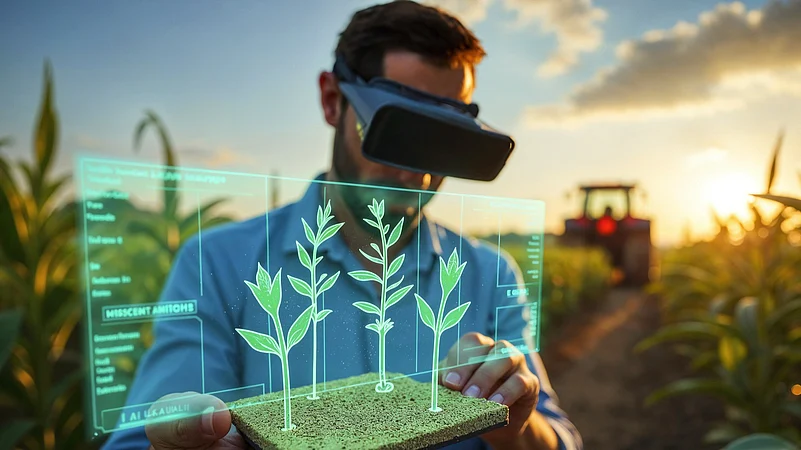
Many Indian companies and start-ups are using AI to meet environmental goals, applying it to ESG data analysis and emissions forecasting.
Firms like Tata Power, ReNew and climate-tech startups are leveraging AI for renewable energy forecasting, predictive maintenance, waste sorting and climate-resilient farming.
Despite its environmental promise, AI models consume massive electricity and water. Frontrunners in the space are focusing on sustainable AI, but large-scale adoption remains a challenge.
It begins, as many revolutions do, with a quiet infiltration. In offices and factories across India, artificial intelligence is slipping into the rhythms of daily work: reading medical scans in the morning, optimising supply chains by lunch, forecasting monsoon patterns by evening. Its gift is a kind of clairvoyance: the capacity to assemble millions of fragments, data points about emissions, weather, markets, into a coherent picture of what’s coming, and how to prepare. Even the smallest companies now seek its counsel.
Such aggressive adoption owes less to techno-utopian zeal than to pressure from capital and regulators. Investors are asking harder questions, ESG-linked finance is attaching conditions and tighter disclosure regimes such as BRSR are dragging metrics into the open. In that mix, AI has graduated from pilot project to boardroom instrument, deployed to count carbon, model risk and document progress that will withstand scrutiny.
According to IBM’s 2024 State of Sustainability Readiness Index, 64% of Indian companies are already deploying AI to meet environmental targets against a global average of 44%. Even tech leaders like Japan fall behind India, with only 31% of their companies currently using AI for sustainability. Even more telling: 98% of Indian companies plan to increase AI investment in their sustainability efforts this year.
Namrata Rana, National Head of ESG, KPMG India says, “AI is helping businesses move from reactive ESG governance to predictive and adaptive frameworks. By analysing vast datasets from sensors, supply chains and stakeholder feedback, AI systems can identify emerging risks and opportunities, simulate sustainability scenarios and recommend interventions before issues escalate.”
Infosys is a classic example. Driven by its AI prowess, the Bengaluru-headquartered software major achieved carbon neutrality in 2020 much earlier than its counterparts backed by a 55% per-capita cut in energy use since 2008, 60 MW in solar capacity and a portfolio of carbon offsets that touch over 100,000 rural households. It was the first Indian company to join RE100, a global commitment to 100% renewable electricity.
And now it is helping other businesses with their carbon neutrality journey by combining its cloud and AI expertise to deliver an intelligent digital solution designed to embed sustainability into its clients’ very core. Infosys Sustainability Cloud is enabling businesses develop ESG strategies and reporting frameworks, create green software and data centres, and design smart and sustainable buildings across various sectors. It is also helping them to enhance supply chain sustainability with tools to monitor GHG emissions and lifecycle assessments.
Such systems matter because the bulk of a company’s climate burden often hides in Scope 3 emissions—those embedded in sprawling supplier networks and product lifecycles—that resist conventional tracking. Here, platforms like Infosys Sustainability Cloud can knit together disparate operational, supplier and product data into a single, verifiable stream, producing auditable reports that satisfy both regulators and investors while revealing actionable efficiencies.
There are others using AI solutions in smart HVACs (heating, ventilation and air conditioning), predictive water use and machine-learning-based emissions monitoring. Tata Power, a frontrunner in the space, is leveraging real-time and predictive weather data to forecast solar energy generation for both day-ahead and intra-day planning, which helps optimise grid integration and ensure efficient solar power utilisation. Its AI-powered weather portal provides hyper-local weather forecasts aiding discoms with early alerts to extreme weather events and enhancing grid reliability and disaster preparedness.
"AI is helping companies spot exactly where resources are being wasted and test different solutions before making changes," says Mahesh Ramanujam, CEO of Global Network for Zero (GNFZ). GNFZ's client Mindspace Business Parks uses an AI-enabled operations center integrated with building systems to monitor energy and water in real time and automate carbon accounting across parks.
He says, "AI-led solar panel cleaning schedules have been shown to reduce water use by up to 25% without loss of output." At scale, they mean millions of kilowatt-hours saved, thousands of tonnes of CO₂ avoided and millions of litres of water conserved each year.
ReNew has similar systems in place. It uses AI in generation forecasting, preventive maintenance, power trading, price forecasting, hybrid RE project sizing and scenario modeling, increasing efficiency of its processes. "The AI-based sizing optimisation model for green hydrogen and ammonia/methanol plants has reduced optimisation time by 90% and excess power by 50%. AI has also reduced non-degradable waste at wind sites by 59% and, through dust accumulation insights, lowered solar panel cleaning water use by 70% at certain locations," says company's co-founder and chairperson sustainability Vaishali Nigam Sinha.
“AI has already demonstrated tangible impact across sectors,” says Rana. In smart buildings, AI regulates lighting and HVAC based on occupancy and weather, significantly reducing energy consumption. Logistics platforms use it to optimise delivery routes, cutting fuel use and emissions. In manufacturing, predictive maintenance reduces downtime and energy waste.
Rana who has experience working with businesses across sector, says, “There is a clear growing demand for AI-based solutions. Clients are seeking real-time ESG dashboards, AI-powered risk assessment tools and platforms that support sustainability-linked financing.” Digital twins, which is also used by ReNew, allow companies to simulate and optimise sustainability scenarios. These are gaining traction “reflecting a broader shift toward active ESG performance management, driven by investor expectations and regulatory pressures,” she adds.
This demand is spilling into capital markets. Sustainability-linked loans and green bonds now arrive with stiffer covenants that ask for evidence, not assurances. AI-based measurement and verification are fast becoming the price of admission: issuers that cannot produce timely, audit-ready data will pay more for capital or go without.
Smart Clean-tech Start-ups
But it is not just the legacy players making impressive strides. There are over 800 active climate-tech start-ups in India. Alt Carbon is one of them. It is building Atlas, an AI platform designed to monitor enhanced rock weathering, a process that captures carbon by accelerating natural soil and mineral interactions. If it works at scale, Atlas could capture up to 5mn tonnes of CO₂ by 2030, while generating a new class of measurable, verifiable carbon credits.
The carbon-credit upside is more than a climate story. It’s an emerging asset-class play. Verified credits from nature-based and AI-assisted methods are projected to tighten in supply and surge in value by the late 2020s. By proving Atlas’s capabilities early, Alt Carbon could shape pricing dynamics, influence market standards and lock in first-mover advantage in a segment poised for scarcity.
Start-ups like Fasal, SatSure, Cropin and DeHaat are rewiring the agri-tech space. While Fasal helps farmers by using IoT and AI for alerts on irrigation, pest or disease warnings and farm-level weather forecasting, Cropin leverages AI, IoT and satellite data to optimise irrigation and reduce fertiliser use, boosting climate resilience.
In the recycling space, companies like Ishitva Robotic Systems are deploying robotic and AI-driven systems to automate and scale waste sorting efficiently. Its founder Jitesh Dadlani says, "We have deployed 100 sorters which can sort without washing PET waste, thus saving water."
The infrastructure is strengthened by AI-led ESG tools entering the mainstream. EY’s ESG Compass, for example, is already automating disclosure workflows, tracking performance against internal and external benchmarks and flagging compliance gaps.
Massive Energy-Guzzler
The benefits of AI come at a steep environmental cost. Like the dreamboat American limousines of the 1970s, these systems are serious gas guzzlers. Goldman Sachs reckons each ChatGPT query consumes ten times the electricity of a Google search, and warns that that AI-driven data-centre demand could swell by 160% by 2030. In India, water is as critical as power. Many data centres, the engines of AI training and inference, sit in water-stressed states such as Maharashtra and Telangana. As workloads mount, industrial cooling risks competing with municipal taps. Without rapid shift to closed-loop systems and aggressive recycling, AI’s green promise can run dry before it can deliver.
If AI systems are built on emission-heavy foundation, the energy savings they deliver won’t translate into a net environmental benefit. According to Pure Storage’s survey conducted last year, compute power needs doubled in 42% of the Indian organisations, storage demands doubled in 41% of them and 74% of them were concerned about AI’s impact on energy use and ESG goals. The solution lies in powering AI systems through renewable energy and using energy-efficient computations.
ReNew runs its AI workloads on AWS and Azure data centers, both of which are powered by 100% renewable energy. While Microsoft Azure has operated on renewables since 2014, AWS is targeting 100% clean energy by 2025. ReNew's Sinha says, "We optimise AI models and workloads to use computational resources efficiently, minimising unnecessary energy consumption."
Some companies have started focusing on building responsible AI solutions. "By optimising algorithms, reducing unnecessary computations and streamlining code, developers can ensure that AI models run more efficiently," Rana of KPMG says.
Infosys claims to offer sustainable AI solutions. IBM too says its AI systems and data centres are sustainable. Subhathra Srinivasaraghavan, vice president, India Systems Development Lab, IBM says, “We’re building systems that don’t just support AI but power it efficiently, securely and sustainably.”
She adds, “Our latest AI Infrastructure launches, IBM Power11, LinuxONE 5 and IBM z17, are designed to help enterprises run advanced AI workloads while reducing energy use, lowering emissions and managing operational costs.” While IBM Power11 servers come with new energy efficient mode, improving server efficiency by 28%, LinuxONE 5 supports large-scale workload consolidation with up to 65% reduction in energy use and over 109 metric tonnes of CO₂e saved per year—the equivalent of removing 24 cars from the road. “They are built with sustainable materials and end-of-life recycling programmes,” says Srinivasaraghavan.
The real choke point is not among the giants but in the messy middle. Thousands of mid-sized firms lack the data scientists or ESG analysts needed to deploy AI with any sophistication. Low-code tools are nibbling at the problem, but adoption remains patchy. Closing this gap will demand more than cheerleading: It will require targeted state incentives, pooled infrastructure and public–private schemes to give smaller firms access to sustainable AI platforms.
Policy will need to sprint to keep up. Without sharper rules and coordinated support, a technology pitched as a planetary cleaner could end up adding to the mess. Boardrooms are already recasting environmental sustainability as a data problem, with AI cast as the fix. The unanswered question is whether ambition can be tempered by restraint. Smarter technology is not enough; it must be cleaner, too.


































